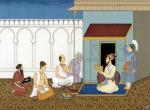Verrier Elwin dedicated his life first to live with Maria and Muria tribals of Bastar (both groups belong to the Gond family) and then the tribals of the North East in what is now Arunachal Pradesh. Pt. Nehru had a liking for and faith in Elwin and many of our policies relating to the tribes were based on the thoughts of Verrier Elwin. Elwin felt that the tribals are a very special people who must be kept separate from the rest of Indian society in order to conserve and preserve their ethnic identity, their tribal social structures, their culture and their way of life. He strongly believed that contact with the rest of India would place the tribals in an unequal contest with the nontribal people and would expose them to virtually unlimited exploitation. In a way this is a policy which the American Government followed vis-à-vis their own indigenous American population, who were confined to earmarked reserves and kept from assimilation into mainstream American society. It is almost as if these people were an endangered species of wild life whose habitat had to be shut away from ordinary society. The fact that mainstream America was the guilty party and that the American Indians were an endangered species because of threat of extermination held out by the new settlers seems to have been lost sight of. .
The legacy of Elwin is Scheduled Areas and Inner Line Areas which were kept isolated from the rest of India. Even today an Indian citizen requires a permit to visit a designated Inner Line Area. This would work where the means of transport and communications were limited to such an extent that this restricted the mobility of people. The Second World War, which brought a foreign enemy into our tribal areas, especially Nagaland and Manipur, saw the massive induction of the Indian Army in order to fight the Japanese and this certainly ended the isolation of the North East. As the war ended and the armies receded they left behind the merchants, tradesmen and other camp followers from all over India and they settled in the tribal areas. As a people they were different from the North Eastern Tribals and whereas a degree of interdependence developed between tradesmen and locals, a large number of exploitative businessmen also came in and certainly there was resentment as they began to exploit the tribals. Verrier Elwin would no longer be relevant in a situation in which tribal society was forcefully projected into what passed for mainstream India, in which the tribals were untrained, uneducated and not oriented to deal with these externalities which now impinged on their daily lives. The genesis of a great deal of unrest in North East can be traced to this unplanned intermingling of, say, the Marwaris of Rajasthan, Bihari labour and the locals in Meghalaya, Nagaland, Mizoram, etc. Verrier Elwin’s theory of keeping the tribals isolated left them unprepared for all external influences and this has had a very unhealthy effect on the economy, social structure and behavioural patterns of the tribals of the North East. This is one of the major causes of insurgency.
In Bastar the size of the district, its remoteness, the density of the forests and the entirely Gond tribal nature of its people had kept the district fairly isolated from the rest of Madhya Pradesh and adjoining States. However, roads were built, settled administration did penetrate the region and a degree of interaction between tribals and nontribals did take place. So long as the pace was evolutionary it did not present many problems. However, two major developments took place which completely transformed the district and not necessarily for the good. The first was settlement of large number of refugees from East Pakistan (Now Bangladesh) in the Dandakaranya area of Bastar and adjoining Koraput District of Orissa. In Bastar the largest such development was in the Pakhanjor area of the north and west of the district. Vast areas of forest land were cleared and whereas the tribals were not allotted land the refugees were settled on it, thus causing simmering resentment amongst the tribals. The second major development was the discovery of what is perhaps the finest iron ore in the world, the blue dust of Bailadila. The forests of this region, which is drained by the Dankhani and Shankhani rivers, represented semi moist deciduous and evergreen forests of Central India at their climax. It had been reported that as late as the second half of the nineteenth century Bailadia was an abode of the one horned Indian rhinoceros.
The people of Bailadila were very backward as their exposure to nontribal society was negligible. Suddenly into this region was unleashed the National Mineral Development Corporation (NMDC), with its huge machines such as excavators, front end loaders, dumpers, large drilling rigs and explosives for blasting. The tribals had never seen such equipment, they were not trained to operate it and certainly they were quite unprepared for the influx of a whole army of workers from outside the region. Virtually in the twinkling of an eye their forests were destroyed, their land pitted and cratered, their rivers polluted, their homesteads gone and their farms rendered useless. They received some cash compensation but they were totally untrained to handle cash and soon the money was gone. In what can only be called an act of barbarism the tribals were rendered homeless, without work, their tribal society substantially destroyed because their social structures broke down as the people were scattered and their women virtually sold into prostitution. This is the inevitable fate of any group of people which finds that the cocoon around it has been shattered and the people rendered helpless by the relentless blows of external factors. Had India educated, trained and helped the tribals in acquiring new skills neither Baildila nor Pakhanjor need have occurred. India could not adopt a policy of keeping the tribals in designated reserves, nor does its Constitution allow it to deny any Indian the opportunity for progress and, therefore, Verrier Elwin’s thoughts ultimately proved fatal to tribal society.
Amongst the major tribes in India are Bhils of Western Madhya Pradesh, Northern Gujarat and adjoining areas of South Eastern Rajasthan. The largest concentration of Gonds is to be found in Jhabua, including Alirajpur, Dhar, Ratlam and Khargone in Madhya Pradesh, Panchmahals in Gujarat and Dungarpur, Bhilwara Banswara and Udaipur Districts of Rajasthan. Of these Jhabua is more than ninety percent Bhil and about seventy percent of the population of Dhar is Bhil and allied tribals such as Bhilalas and Patelias. Of all the tribes in India the Bhils have had the longest contact with nontribal people. The Bhils are basically war like, live in nuclear families, are highly individualistic, every Bhil has his own little compound or falia on his own little isolated hilltop and the nearest people to them that I can think of are the independent Highland clans of Scotland. Bhil warriors formed part of Maharana Pratap’s army, they fought for the British as part of the Malwa Bhil Corps and even today the Bhil continues to be hardy and independent. He is fond of alcohol, loves music and can dance all night and he fiercely protects his individual freedom.
The Bhil districts, especially Jhabua and Dhar, are hilly, have poor soil which cannot retain moisture, have been massively deforested and this has caused environmental degradation and because of these unhealthy practices soil productivity is low. Jhabua has about thirty five inches of rainfall per year but the rainfall pattern is erratic. Once in three years invariably there is a drought and because the forests have been felled and there is soil erosion, water run-off is rapid and ground water is in very short supply. All these have adversely affected agriculture and, therefore, the Bhils are forced into seasonal migration in search of livelihood. After the kharif harvest is in one rarely finds any adult male in a Bhil village because all of them have gone out in search of work. This seasonal migration brings the Bhils into contact with the rest of India, though only in the form of unskilled, underpaid labour. Nevertheless, the Bhils are aware of what is going on elsewhere and to that extent they are not isolated like the tribals of Bailadila or Nagaland. That is also perhaps one reason why in the matter of religion there is considerable sanskritisation of the Bhils. What is surprising is that despite all the external influences and interactions with nontribal people the Bhil identity is not totally lost and one can still clearly recognise the Bhil as a tribal and his society and culture as typically Bhil. There have been changes, which is only to be expected as external factors begin to operate, but it says much for the innate strength of Bhil culture that it has been able to retain its own individual identity whilst reacting to the modern influences which now operate.
The Bhil districts in Madhya Pradesh, being drought prone, have had at least sixty years experience of government intervention through relief works. I remember that some years ago the Engineer-in-Chief of the Madhya Pradesh Public Works Department told me that there was enough aggregate and stone dust collected in the districts through relief works to be able to pave every road in the State. The philosophy of relief works was that the work should be arduous, not permanently productive but of a nature such that only the really needy would come forward for it. In fact there was a time when were told that it was perfectly in order to dig holes and then fill them up because the idea was not so much to undertake public works as to provide employment. Fortunately this philosophy changed when the drought prone areas programme, integrated rural development programme, watershed management programme and now the National Employment Guarantee Scheme came into being. The ruling philosophy is that rural works should be taken up with the objective of creating permanent assets which could benefit village society and economy, improve water and land management and create assets which could help to ameliorate poverty. Jhabua is one district where large scale watershed management programmes have been implemented and this has definitely improved water availability in a number of villages, increased fodder supply and by bringing many hill features under afforestation, has brought about long term stabilisation and improvement of ground water. This, in turn, has had some effect in the matter of seasonal migration. The indications are that it is possible to improve the water situation in Jhabua and to increase soil productivity, which would inevitably bring about a major change in the migration pattern. Unfortunately the National Rural Employment Guarantee Scheme as it is designed today and operates in the field has diluted the Watershed Management Programme and this is not a healthy development. Government must have a review of NREGS to see how it can be made an effective instrument in the creation of permanent village assets, especially through the Watershed Management Programme.
I have been visiting Jhabua on and off and have been a keen observer of how Bhil society has evolved over the last fifty years. Certainly in the villages where the Watershed Management Programme brought about improvement one can see that irrigated cultivation has caught on and one see horticultural crops where none existed before. For example, in Petlawad Tehsil of Jhabua District there is extensive cultivation of tomatoes and chillies, both products which have a ready market. It is a pleasure to see stacked against walls of even mean hutments plastic crates used for transporting tomatoes to market. We need to expand this activity much further, but the inhibiting factor is that the markets are far away and there is considerable spoilage of what is a delicate agricultural product and the money which goes to the farmers is only a fraction of the price at which the product sells in the retail market. The pro FDI lobby would immediately argue that if we allow foreign retail chains to enter the market they would take care of this problem, arrange to collect the horticultural products from rural areas and give a good price to the farmers. Those who know Jhabua well would realise that no FDI retail chain will penetrate into this remote region in the immediate future. Therefore, the true answer is for indigenous processing units to add value to the product by conversion of tomatoes into puree, sauce, juice or even tinned tomatoes. The processing units would be in the small and medium industry class, they would be local based because it is easier to transport the processed product than it is to transport the raw product and they would provide local employment for which the skill level required is not very high and for which the tribals, especially the women, can be easily trained.
I brought this up in a meeting of the district officers and whereas the officer in charge of horticulture welcomed the idea, the officer in charge of industries said that the scale of production did not attract entrepreneurs to set up units. I had to tell the District Collector that the two officers should sit together, the Industries Department officer should project the minimum requirement of the processing industry and the horticulture officer should then try and increase production of tomatoes or any other horticulture product to a level where a processing industry could operate with profit. I am mentioning this specific case because if we have the correct mental approach and there is coordination many of these seemingly trivial problems can be solved locally.
The main problem appears to be that because of generations of seasonal migration the people of Jhabua seem to have lost faith in their own ability to make a good living out of land and have also lost faith in land as a provider of livelihood. I remember visiting the Punjab Agriculture University at Ludhiana some years ago. There were large groups of farmers thronging the campus because they had heard that the university had successfully experimented with a new variety of wheat. They wanted to know all about it so that they, too, could benefit from this research by sowing the new variety of seed. The Punjab farmer is confident that he can earn a living from the land and he is independent enough to want to be his own master. However, in the Bhil mind wage employment has become almost an embedded idea and, therefore, everyone I met in Jhabua wanted more wage employment and better wages. There was very little demand for the kind of land and water management techniques which would help to increase soil productivity and give the Bhils a good livelihood based on land, cultivation and allied activities such as cattle breeding, etc. Because of this mind set the Bhil tribal has become excessively dependent on wage employment and to that extent he has lost his independence. That is why agricultural productivity in Jhabua is stagnant and the Bhil is, in a way, now bonded as a worker in wage employment programmes whose objective is to give employment but not necessarily to increase productivity or create assets. According to me this is the single most harmful development in the land of the Bhils, the psyche of the Bhils and their attitude towards permanent upliftment. We need to break this and to bring the Bhil back to a state where land becomes all important and the desire to earn a good living from land overpowers and, perhaps, eliminates the desire for wage employment.
How does one do this? One obvious answer is coverage of the district and all Bhil areas with a watershed management programme which is universal and covers every mili and micro watershed in the region. Villages Jakhela, Khardubadi, Kharduchhoti, etc., are living examples of what watershed management can do. Thousands of acres of hill features have been brought under afforestation and they have magnificent grasses, shrubs and trees which have transformed these barren hills and have even attracted wild life. I have personally run into a pantheress and two cubs on the Khardubadi hill and there are reports of a tiger being sighted at Jakhela. Avifauna abounds where there was none before. The greening of these hills and the treatment of the rivulets and the streams in the area has revived all wells in eight villages and more than fifty new wells under the Kapiladhara Scheme have been sunk. There is no migration from these villages. This is the kind of programme which must be undertaken throughout region.
There is a Krishi Vigyan Kendra (KVK), or Agriculture Science Centre in Jhabua. Excellent work is being done there on the breeding and extension of Kadaknath breed of poultry, which is unique both nationally and internationally because the bird is black and its flesh is black. In fact an IPR patent should be taken out for this bird because it does not exist anywhere else in the world outside Jhabua. But KVK Jhabua needs to go much further. It and the agriculture and horticulture departments of government must demonstrate on a very large scale throughout the Bhil areas that even with erratic rainfall, periodic droughts, poor soil and the present low productivity it is possible for us to agriculturally transform Jhabua through correct soil and water management practices, careful choosing of crop varieties to suit the local agro climatic conditions and the adoption of agricultural operations which are well planned. If hundreds of such demonstrations could be held throughout the district we should be able to convince the tribals that they can make a living from their land and that they need not seek wage employment.
What would be the advantage of such an approach? Improving the land is in itself one of the most environment friendly exercises that we can think of. Making the land yield enough to bring prosperity to Bhils would be a permanent reversal of environmental degradation and would certainly improve nutrition standards dramatically. Reduction or even elimination of seasonal migration would enable children to be educated because they would be stable in their own villages and, therefore, the school system could be improved. This is equally applicable to health care, which is difficult to provide if people are migrating to distant places. As Bhil society prospers and as stability of population returns because there is very little seasonal migration, traditional Bhil culture would be strengthened because now on their home ground the Bhils would be able to tackle externalities on an equal footing. If I were to be asked what is the one factor which can give strength to Bhil society I would say that we must replace the mindset of wage employment by a desire for self-employment and this would release the innate entrepreneurial skills of tribals who are determined to stand on their own feet.
Published Date: 17th October 2012








Post new comment